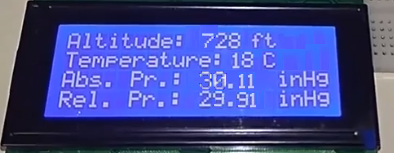壓力感測器BMP180和Arduino裝置進行溫度,壓力和高度測量
這是一個使用壓力感測器BMP180和Arduino裝置進行溫度,壓力和高度測量的物聯網(物聯網)專案。
在這個專案中,我們將建立一個溫度,壓力和高度測量系統。使用氣壓感測器模型BM 180來檢測溫度,大氣壓力和海拔高度,Arduino裝置和16 X 4字元LCD顯示計算的溫度,壓力和海拔高度。
硬體要求
- Arduino UNO主機板
- 用於Arduino裝置的USB電纜連線器
- 壓力感測器BMP180
- 16 X 4字元LCD顯示屏
- 專案主機板
- 跳線(公線對公線,公線對母線)
軟體要求
- Arduino軟體IDE
壓力感測器BMP180的工作原理
壓力感測器BMP180由壓阻式感測器,模擬和數位轉換器,帶E2PROM的控制單元和序列I2C介面組成。它提供溫度,大氣壓力和海拔高度的貢獻值。感測器裝置的微控制器傳送啟動序列以測量溫度,壓力和高度。溫度,壓力和高度的值通過16X4字元LCD讀取。
計算的溫度,壓力和高度分別以℃(攝氏度),hPa(hector Pascal)和英尺為單位測量。在這種情況下,測量溫度,大氣壓力和高度的速率是每秒一次。
高度和壓力彼此成反比。當海拔升高時,壓力下降,當海拔降低時,導致大氣壓力增加。
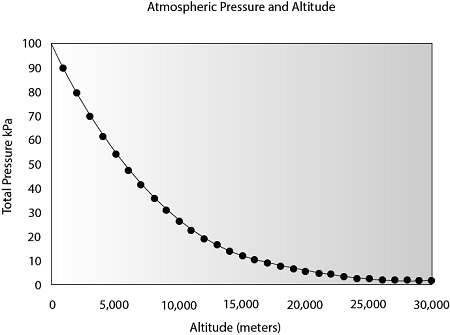
使用壓力感測器BMP180,Arduino和字元LCD編寫Arduino程式來測量溫度,壓力和高度。
#include <LiquidCrystal.h>
LiquidCrystal lcd(13, 12, 11, 10, 9, 8);//RS,EN,D4,D5,D6,D7
#include <SFE_BMP180.h>
#include <Wire.h>
//create an SFE_BMP180 object, here called "pressure":
SFE_BMP180 pressure;
#define ALTITUDE 222.0 // altitude of Delhi in meters
void setup(){
Serial.begin(9600);
Serial.println("BMP180 Measurements");
lcd.begin(20, 4);
lcd.setCursor(0, 0);
lcd.print("BMP180 Measurements");
lcd.setCursor(0, 1);
lcd.print(" 1. Temperature");
lcd.setCursor(0, 2);
lcd.print(" 2. Pressure");
lcd.setCursor(0, 3);
lcd.print(" 3. Altitude");
delay (5000);
lcd.clear();//clear display
// initialize the sensor (it is important to get calibration values stored on the device).
if (pressure.begin())
Serial.println("BMP180 init success");
else{
// oops, something went wrong, this is usually a connection problem,
// see the comments at the top of this sketch for the proper connections.
Serial.println("BMP180 init fail\n\n");
while(1); // pause forever.
}
}
void loop(){
char status;
double T,P,p0,a;
// loop here getting pressure readings every 10 seconds.
// if you want sea-level-compensated pressure, as used in weather reports,
// you need to find dinamically altitude of place.
// here, we are using constant called ALTITUDE in this sketch:
Serial.println();
Serial.print("provided altitude: ");
lcd.setCursor(0, 0);
lcd.print("Altitude: ");
Serial.print(ALTITUDE,0);
Serial.print(" meters, ");
Serial.print(ALTITUDE*3.28084,0);
lcd.print(ALTITUDE*3.28084,0);
Serial.println(" feet");
lcd.print(" ft");
// start a temperature measurement:
// if request is successful, the number of ms to wait is returned.
// if request is unsuccessful, 0 is returned.
status = pressure.startTemperature();
if (status != 0){
// wait for the measurement to complete:
delay(status);
// retrieve the completed temperature measurement:
// note that the measurement is stored in the variable T.
// function returns 1 if successful, 0 if failure.
status = pressure.getTemperature(T);
if (status != 0){
// Print out the measurement:
Serial.print("temperature: ");
Serial.print(T,2);
Serial.print(" deg C, ");
Serial.print((9.0/5.0)*T+32.0,2);
Serial.println(" deg F");
lcd.setCursor(0, 1);
lcd.print("Temperature: ");
lcd.print(T,2);
lcd.print(" C ");
// start a pressure measurement:
// the parameter is the oversampling setting, from 0 to 3 (highest res, longest wait).
// if request is successful, the number of ms to wait is returned.
// if request is unsuccessful, 0 is returned.
status = pressure.startPressure(3);
if (status != 0){
// wait for the measurement to complete:
delay(status);
// Retrieve the completed pressure measurement:
// Note that the measurement is stored in the variable P.
// Note also that the function requires the previous temperature measurement (T).
// (If temperature is stable, you can do one temperature measurement for a number of pressure measurements.)
// Function returns 1 if successful, 0 if failure.
status = pressure.getPressure(P,T);
if (status != 0){
// print out the measurement:
Serial.print("absolute pressure: ");
Serial.print(P,2);
Serial.print(" mb, ");
Serial.print(P*0.0295333727,2);
Serial.println(" inHg");
lcd.setCursor(0, 2);
lcd.print("Abs. Pr.: ");
lcd.print(P*0.0295333727,2);
lcd.print(" inHg");
// The pressure sensor returns absolute pressure, which varies with altitude.
// To remove the effects of altitude, use the sea level function and your current altitude.
// This number is commonly used in weather reports.
// Parameters: P = absolute pressure in mb, ALTITUDE = current altitude in m.
// Result: p0 = sea-level compensated pressure in mb
p0 = pressure.sealevel(P,ALTITUDE); // we are at 222 meters (Delhi)
Serial.print("relative (sea-level) pressure: ");
Serial.print(p0,2);
Serial.print(" mb, ");
Serial.print(p0*0.0295333727,2);
Serial.println(" inHg");
lcd.setCursor(0, 3);
lcd.print("Rel. Pr.: ");
lcd.print(p0*0.0295333727,2);
lcd.print(" inHg");
// On the other hand, if you want to determine your altitude from the pressure reading,
// use the altitude function along with a baseline pressure (sea-level or other).
// Parameters: P = absolute pressure in mb, p0 = baseline pressure in mb.
// Result: a = altitude in m.
a = pressure.altitude(P,p0);
Serial.print("computed altitude: ");
Serial.print(a,0);
Serial.print(" meters, ");
Serial.print(a*3.28084,0);
Serial.println(" feet");
}
else
Serial.println("error retrieving pressure measurement\n");
}
else
Serial.println("error starting pressure measurement\n");
}
else
Serial.println("error retrieving temperature measurement\n");
}
else
Serial.println("error starting temperature measurement\n");
delay(5000); // Pause for 5 seconds.
}
從 https://github.com/LowPowerLab/SFE_BMP180 下載SFE_BMP180-master.zip檔案
在編譯上面的程式碼之前新增SFE_BMP180-master zip檔案,否則會生成錯誤SFE_BMP180.h:沒有這樣的檔案或目錄。
要新增zip檔案,請單擊:Sketch -> Include Library -> Add .ZIP Library… 並新增下載的SFE_BMP180-master zip。
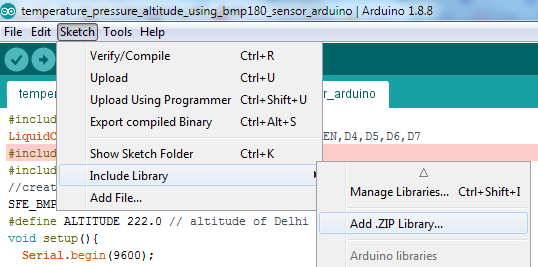
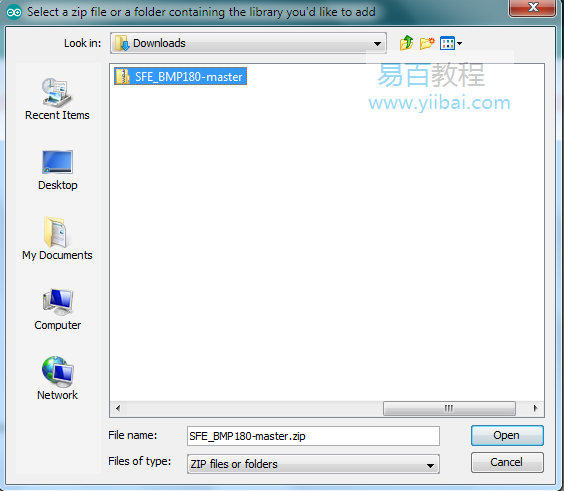
編譯並將程式碼上傳到Arduino裝置。然後,相應地連線所有裝置。Arduino,BMP180和16 X 4字元LED的數位電路如下:
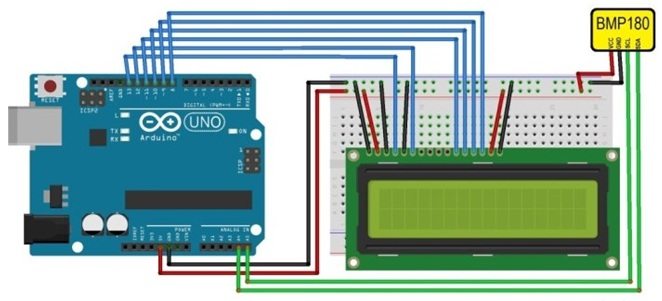
執行後,得到以下結果:
